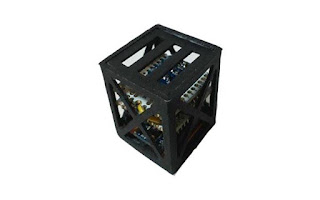 |
| Kalamsat |
NASA scientists have been unable to create the
smallest satellite ever until now.. Indians once again made history
by designing and building world's smallest and lightest satellite on
behalf of 'Space Kidz India’, a Research Organization based on
Chennai for children. Kalamsat is the brainchild of Rifath Sharook,
an 18-year-old boy, from Tamil Nadu’s Pallapatti town, India. Others on the team include Tanishq Dwivedi (flight engineer), Vinay S
Bhardwaj (design engineer), Yagna Sai (lead technician), Mohammed
Abdul Kashif (lead engineer) and Gobi Nath (biologist). For the past four years, these young minds have been working on rocket and space technology under the mentorship of Chennai-based Srimathy Kesan, the founder and chief executive officer of Space Kidz India
When the US’ National Aeronautics and Space
Administration (Nasa) launches the world's smallest and lightest
satellite KalamSat on June 21, 2017, it will be the first time ever
that it would be piloting an experiment by an Indian student.
Kalamsat is the only Indian payload in the mission. The weight of the
probe is only 64 grams and it is fitted in a 3.8 centimeters cube. It
is the first satellite to be manufactured via 3D printing. The device
is made from 3D printed carbon fibre, and was the winning entry in
Cubes in Space, a design contest for young inventors organised by
education company idoodle, with backing from Nasa and the Colorado
Space Grant Consortium.
Rifath has named his creation KalamSat, after
former Indian president and nuclear scientist Abdul Kalam. It will be
launched from Nasa's Wallops Island facility in the US next month,
entering into a four-hour sub-orbital flight i.e. it will not be
placed into orbit. For 12 minutes of the flight it will be operating
in a micro-gravity environment. The mission will last for 240
minutes. It took more than two-years for Rifath and his team to
design the experimental satellite using the 3-D printing technology
at a cost of just ₹1 lakh.
Sharook says the purpose of his experiment is to
see how 3D printed carbon fiber-reinforced polymer (CFRP) performs in
the microgravity of outer space. It owes its lightness to its
reinforced carbon fibre polymer frame, a material that has a
super-high strength-to-weight ratio, and is used in everything from
aerospace engineering to fishing line. Kalamsat contains a new kind
of on-board computer and eight indigenous built-in sensors such as
temperature and humidity sensor, a barometric pressure sensor and a
Nano Geiger Muller counter to capture and record temperature,
radiation level, rotation buckling, magnetosphere of earth and others
before landing in the ocean. It has strain gauges which will be used
to study the structural performance of the 3D printed parts by
measuring the deformations. Information received through the
satellite will help us in building better spacecraft. It can be used
for back-up communications in disasters.
Though there are no specific advantages for this
satellite. It can be used as a test bed to evaluate the 3D printed
materials and can be used as a kit to teach the satellite
construction and operation in future... Its surely another moment of
pride and joy for all indians...

No comments:
Post a Comment